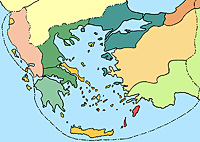 |
|
 |
 he main goal of the foreign policy of
Theodore I was
the expansion of the borders of the Empire of Nicaea at the expense of the Latins as well as of the Turks of Asia Minor and, he main goal of the foreign policy of
Theodore I was
the expansion of the borders of the Empire of Nicaea at the expense of the Latins as well as of the Turks of Asia Minor and,
 ultimately, the recovery of Constantinople, which had been in Western hands since 1204. All of Theodore's activities were thus focused on the achievement of this goal.
ultimately, the recovery of Constantinople, which had been in Western hands since 1204. All of Theodore's activities were thus focused on the achievement of this goal.
After the defeat of the Latins in Adrianople and the capture of their emperor,
Baldwin,
in April 1205, Theodore I managed to drive the Franks out of Asia Minor. But
Eric, who
succeeded Baldwin as Emperor, was able to restore to a great extent the Latin occupation of Thrace and to launch an expedition in Asia Minor in 1206. With Venice acting as an intermediary, the Latins, together with the Turks of Ikonion, took action against Theodore.
 Laskaris, with only the King of Armenia Minor, Leo I (1198/9-1219), on his side, managed to defeat the Sultan of Ikonion in the spring of 1211, at Antioch on the Meander. Soon after, though, on 15 October 1211, he was defeated by Eric's forces at the battle of the Rhyndakos river.
Laskaris, with only the King of Armenia Minor, Leo I (1198/9-1219), on his side, managed to defeat the Sultan of Ikonion in the spring of 1211, at Antioch on the Meander. Soon after, though, on 15 October 1211, he was defeated by Eric's forces at the battle of the Rhyndakos river.
The skirmishes between the Latins and Byzantines continued until, both parties being exhausted, they finally decided to make peace. Towards the end of 1214 was signed the treaty of Nymphaion, which determined the borders between the Byzantine and the Latin Empires. The Latins were confined to the north-western corner of Asia Minor, as far as Adramyttion, while the rest of the area, up to the borders of the
Seljuk
territories, remained
in the hands of the Byzantines of Nicaea. The treaty of Nymphaion meant recognition of the status quo by both Empires and marked the beginning of a period of stability for the Empire of Nicaea, which eventually also extended its sovereignty over Paphlagonia, the domain of the
Grand Komnenoi.
|